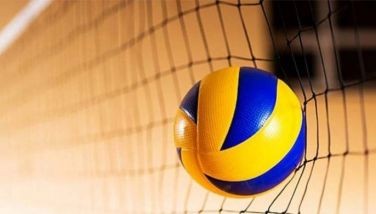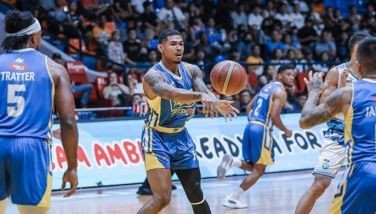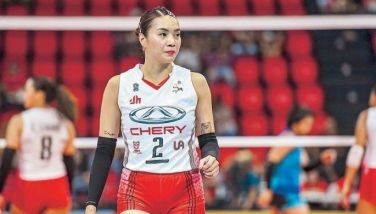Shooting star
May 19, 2003 | 12:00am
Since he entered the tumultuous world of show business, multi-awarded actor Richard Gomez has gotten used to shooting movies. In spite of this, a few months before the 2002 Busan Asiad, this ultimate sportsman found out that there are a lot more to learn and enjoy in "shooting".
Trapshooting is an Olympic sport that requires neither offense nor defense. The concept is to simulate the act of hunting. One only has to shoot the moving target. Basically, one uses a shotgun to shoot clay called "bird". This is however totally different from combat pistol shooting where target is just standing. There are 15 machines that randomly shoot out clay. Motions are rightwards, leftwards, and straight up. The shooters go through five stations, each with voice-activated posts. For every station, they shout to give the machines signal that they are ready. They have two bullets to hit every "bird." A hit is equivalent to one point. One round is 25 shots. Whoever scores the highest after the rounds, wins.
Apparently, fencing is not enough for 46-year old Gomez, more popularly known as Goma. During every South East Asian (SEA) meet, he makes it a point to watch other events — taekwondo, judo, etc. One day, he discovered the firing range and saw trap and skeet shooting. It was during the 2001 Kuala Lumpur SEA Games when Goma approached some of the shooters he knew to inquire about the sport. When he got back to Manila, he started taking it up seriously.
Without a doubt, Goma has found another love. "I know fencing already, how to play it. But with shooting, I’m still learning the ropes," he explains. And the challenge that goes with it acts like a magnet that attracts the sportsman to the range almost everyday to spend roughly about 40 rounds in practice to master this gentleman’s sport. Unlike fencing that requires four hours of his day for training, shooting is less demanding. And unlike draining assaults in fencing, "Shooting doesn’t tire my body out. After practice, I still have energy to do other chores."
Nevertheless, before Goma discovered the wonders of trapshooting, Filipinos have already been excelling in this sport that was started by the Royal families in England during the late 1800’s.
Giving free lessons to Goma and his friends — Jj Wambangco, Manny Cabiling and Mikee Romero — is Coach Manuel "Joey" Valdez. His fascination with trapshooting started when he was only 14 years old. Under the supervision of his father, he went on to achieve milestones in his shooting career, including a record score of 193 points out of 200 shots in Clark Air Base for the Nationals, two bronze medals in the 2002 Asian Games in Busan, and a gold medal in the 1983 SEA Games in Singapore. He is a two-time record-holder in the SEA Games. After Singapore, he shot a record of 186 out of 200 in the 1991 Manila SEA Games.
"The beauty of this sport is that it teaches you to be accurate and perfect in all your movements and reactions to the target. You are not against anyone else but yourself and if you fail, you have also no one to blame but your poor concentration," says Coach Valdez. He goes on to say that in trap, the challenge is to be able to control one’s self. And the reward is being able to zone-out in one’s special world– his mind.
In our country where practically everybody is basketball-crazy, it’s difficult to amass support for other sports. And this is the trap that the elite sport of trapshooting is experiencing now. The complaint is like a broken record that plays the same line over and over– "There’s so much politics in sports."
Because of lack of support, shooters experience lack of supply of ammunition. That’s why for the love of trapshooting, they spend for their own. Expenses include buying a shotgun that costs at least P200,000. Each bullet costs around P10, and a shooter spends about 300 rounds per session. Each clay costs P800 per box of 150.
Currently there are about 30 shooters in Manila who practice at the year-old range in Manila Harbor Center. The Philippine National Shooting Association (PNSA) started renting the land after Fort Bonifacio, the old home of the range, was sold by the government during the Ramos Administration. PNSA is maximizing the use of more than a decade-old clay machines from the Fort Bonifacio range that were used during the 1991 SEA Games held in Manila.
"We’ve been training hard in this event with our limited resources and we’ve been winning medals," asserts Coach Valdez who believes that Filipinos have a big possibility of excelling in this sport. Unlike basketball, tennis, bowling, golf, etc., there are no physical limitations or requirements.
All trapshooting requires is dedication from the athlete. Time for practice is important.
While Italians, French and other European nationals continue to dominate the circuit, the best Filipinos have placed so far was 5th in the 1995 World Cup held in Korea. But that was how many years ago? Is this another case of regression of sport due to neglect of sports officials and agencies?
Next target for shooters is the qualifying for the Vietnam SEA Games to be held in December of this year. Unfortunately, there are only three spots open for skeet shooting, and two for individual trapshooting. Vietnam probably has poor shooters so officials decided to scrap out the team division in trapshooting and concentrate on their stronger events.
This coming weekend, on May 24-25, shooters, Goma included, will have to score 111 out of 125 to qualify for single trap. Fire away, hunters!
For comments and reactions, write to [email protected].
Trapshooting is an Olympic sport that requires neither offense nor defense. The concept is to simulate the act of hunting. One only has to shoot the moving target. Basically, one uses a shotgun to shoot clay called "bird". This is however totally different from combat pistol shooting where target is just standing. There are 15 machines that randomly shoot out clay. Motions are rightwards, leftwards, and straight up. The shooters go through five stations, each with voice-activated posts. For every station, they shout to give the machines signal that they are ready. They have two bullets to hit every "bird." A hit is equivalent to one point. One round is 25 shots. Whoever scores the highest after the rounds, wins.
Apparently, fencing is not enough for 46-year old Gomez, more popularly known as Goma. During every South East Asian (SEA) meet, he makes it a point to watch other events — taekwondo, judo, etc. One day, he discovered the firing range and saw trap and skeet shooting. It was during the 2001 Kuala Lumpur SEA Games when Goma approached some of the shooters he knew to inquire about the sport. When he got back to Manila, he started taking it up seriously.
Without a doubt, Goma has found another love. "I know fencing already, how to play it. But with shooting, I’m still learning the ropes," he explains. And the challenge that goes with it acts like a magnet that attracts the sportsman to the range almost everyday to spend roughly about 40 rounds in practice to master this gentleman’s sport. Unlike fencing that requires four hours of his day for training, shooting is less demanding. And unlike draining assaults in fencing, "Shooting doesn’t tire my body out. After practice, I still have energy to do other chores."
Nevertheless, before Goma discovered the wonders of trapshooting, Filipinos have already been excelling in this sport that was started by the Royal families in England during the late 1800’s.
Giving free lessons to Goma and his friends — Jj Wambangco, Manny Cabiling and Mikee Romero — is Coach Manuel "Joey" Valdez. His fascination with trapshooting started when he was only 14 years old. Under the supervision of his father, he went on to achieve milestones in his shooting career, including a record score of 193 points out of 200 shots in Clark Air Base for the Nationals, two bronze medals in the 2002 Asian Games in Busan, and a gold medal in the 1983 SEA Games in Singapore. He is a two-time record-holder in the SEA Games. After Singapore, he shot a record of 186 out of 200 in the 1991 Manila SEA Games.
"The beauty of this sport is that it teaches you to be accurate and perfect in all your movements and reactions to the target. You are not against anyone else but yourself and if you fail, you have also no one to blame but your poor concentration," says Coach Valdez. He goes on to say that in trap, the challenge is to be able to control one’s self. And the reward is being able to zone-out in one’s special world– his mind.
In our country where practically everybody is basketball-crazy, it’s difficult to amass support for other sports. And this is the trap that the elite sport of trapshooting is experiencing now. The complaint is like a broken record that plays the same line over and over– "There’s so much politics in sports."
Because of lack of support, shooters experience lack of supply of ammunition. That’s why for the love of trapshooting, they spend for their own. Expenses include buying a shotgun that costs at least P200,000. Each bullet costs around P10, and a shooter spends about 300 rounds per session. Each clay costs P800 per box of 150.
Currently there are about 30 shooters in Manila who practice at the year-old range in Manila Harbor Center. The Philippine National Shooting Association (PNSA) started renting the land after Fort Bonifacio, the old home of the range, was sold by the government during the Ramos Administration. PNSA is maximizing the use of more than a decade-old clay machines from the Fort Bonifacio range that were used during the 1991 SEA Games held in Manila.
"We’ve been training hard in this event with our limited resources and we’ve been winning medals," asserts Coach Valdez who believes that Filipinos have a big possibility of excelling in this sport. Unlike basketball, tennis, bowling, golf, etc., there are no physical limitations or requirements.
All trapshooting requires is dedication from the athlete. Time for practice is important.
While Italians, French and other European nationals continue to dominate the circuit, the best Filipinos have placed so far was 5th in the 1995 World Cup held in Korea. But that was how many years ago? Is this another case of regression of sport due to neglect of sports officials and agencies?
Next target for shooters is the qualifying for the Vietnam SEA Games to be held in December of this year. Unfortunately, there are only three spots open for skeet shooting, and two for individual trapshooting. Vietnam probably has poor shooters so officials decided to scrap out the team division in trapshooting and concentrate on their stronger events.
This coming weekend, on May 24-25, shooters, Goma included, will have to score 111 out of 125 to qualify for single trap. Fire away, hunters!
For comments and reactions, write to [email protected].
BrandSpace Articles
<
>
- Latest
- Trending
Trending
Latest
Trending
Latest
Recommended































